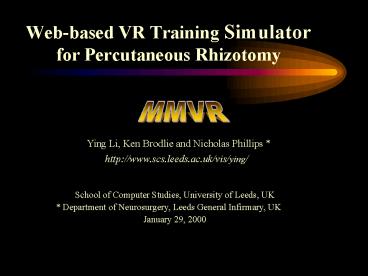Webbased VR Training Simulator for Percutaneous Rhizotomy - PowerPoint PPT Presentation
1 / 14
Title:
Webbased VR Training Simulator for Percutaneous Rhizotomy
Description:
Dissection of carotid artery will affect blood supply to brain. A simple web-based simulator ... Client-based WWW surgical training system is fast, cheap, ... – PowerPoint PPT presentation
Number of Views:57
Avg rating:3.0/5.0
Title: Webbased VR Training Simulator for Percutaneous Rhizotomy
1
Web-based VR Training Simulator for Percutaneous
Rhizotomy
MMVR
Ying Li, Ken Brodlie and Nicholas Phillips
http//www.scs.leeds.ac.uk/vis/ying/
School of Computer Studies, University of Leeds,
UK
Department of Neurosurgery, Leeds General
Infirmary, UK
January 29, 2000
2
Contents
- Motivation
- Surgical procedure
- The simulator
- Conclusions
3
Motivation
- The limitation of current VR training
systems
Dedicated, expensive equipment
- The advantages of web based VR environment
Accessible, scalable, low cost
- It is possible
VRML
4
The Surgical Procedure - Percutaneous Rhizotomy
Insert needle electrode at correct position
orientation on face
Locate puncture foramen ovale to access and
burn ganglion nerve
5
Why is Simulation Useful
- Highly skilled operation
Especially to locate foramen ovale
- Awkward to train new staff
Patient awake for part of the procedure
- Risky
Dissection of carotid artery will affect blood
supply to brain
6
Our Simulator
- A simple web-based simulator
- Aims to be an adjunct to training of
neurosurgeons
Shorten period of training
Understanding of procedure and risks involved
7
The Simulator - Architecture
- Client-based system
Download self-contained simulation to client
Web Server
download
VRML world extended with Java EAI to provide
simulation
Browser
Single download, no dependency on network
8
The Simulator - Virtual World
- Extend reality by multiple views
From the eye of the surgeon
From the eye of the needle electrode
Eye of the surgeon
Eye of the needle
Java EAI
9
The Simulator - Simulating The Surgical Practice
- Place landmarks
- Virtual planes
10
The Simulator - Manipulating The Tools
- Controller
- Rotate and translate
according to rules of surgical procedure
- Three VRML worlds
co-ordinated through Java EAI
11
The Simulator - Hitting The Target
- Collision detection between
objects not supported in VRML
Only collision with viewer
12
Success
13
Oops.
14
Conclusion
- Client-based WWW surgical training
system is fast, cheap,
- Collision detection between needle and
multiple complex objects is efficient
- Various surgical tasks have been simulated
- Complexity versus ease of use ?































